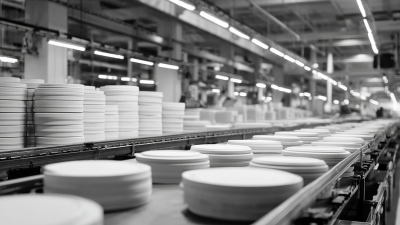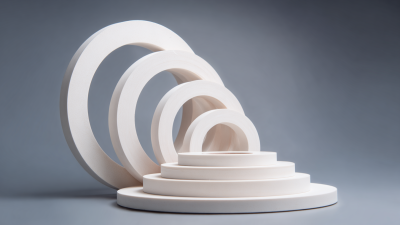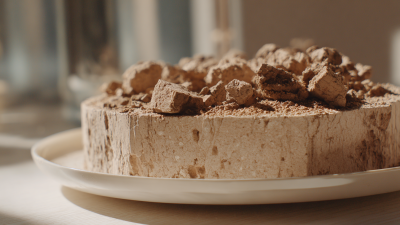Leave Your Message
In the world of pottery, achieving the perfect finish is often dependent on the tools and techniques employed during the firing process. Among these essential tools, the Ceramic Saggar stands out as a vital component for protecting delicate pieces from direct flame and facilitating unique effects through controlled atmospheres. According to the 2021 Pottery Market Report, the global pottery industry has seen a consistent growth of approximately 4.5% annually, with a notable increase in the demand for specialized pottery techniques, including saggar firing. This method not only enhances the aesthetic appeal of ceramics but also contributes to the longevity and durability of the finished product.

As potters strive to elevate their craft, choosing the right Ceramic Saggar becomes crucial for optimizing their creative expression and meeting the rising expectations of contemporary pottery enthusiasts. In this ultimate guide, we will delve into the key considerations and features to help you select the ideal Ceramic Saggar tailored to your unique pottery needs.
When it comes to pottery firing, selecting the right ceramic saggar is crucial for achieving desired aesthetics and functional qualities. There are several types of saggar, each designed for specific applications. For instance, a traditional saggar made from stoneware can withstand high temperatures, making it ideal for wood-fired or salt-fired pottery. According to a report from the Craft Potters Association, nearly 60% of potters prefer stoneware saggars for their durability and thermal properties.

Another popular option is the saggar made from terracotta, which is lightweight and allows for unique atmospheric effects during firing. This type can create subtle color variations on the pottery due to its porous nature. Research indicates that over 70% of ceramic artists utilize terracotta saggars to explore different firing techniques and artistic expressions. Meanwhile, specialized saggars with added materials, such as sawdust or salt, can introduce distinct surface textures and patterns, providing further avenues for creativity in pottery.
Understanding these different types of saggars enables potters to tailor their firing processes and achieve innovative results. As the pottery industry continuously evolves, staying informed about the characteristics and applications of various saggars will empower artisans to elevate their craft and enhance their artistic journey.
Choosing the right ceramic saggar is crucial for achieving optimal results in your pottery projects. One of the primary factors to consider is the size and shape of the saggar. According to the American Ceramic Society, the dimensions of your pieces will influence the saggar's design, ensuring that your pottery is adequately protected during firing. For larger works, a custom-designed saggar may be necessary, while smaller pieces can fit into standard shapes.
Another critical consideration is the material of the saggar itself. Different materials respond uniquely to temperature changes and can affect the final outcome of your pottery. A recent study published in the Journal of Materials Science suggests that saggars made from high-alumina materials exhibit better thermal stability, minimizing the risk of cracking during the firing process.
Tips: Always choose a saggar that complements your clay body’s properties. If you’re working with stoneware, ensure the saggar can withstand high temperatures, typically around 1300°C. Also, consider experimenting with alternative materials like fiber or steel, which can yield unique surface effects in your pieces.
Maintaining and cleaning your ceramic saggar is crucial for optimal performance and longevity, especially considering that properly maintained ceramic tools can increase their lifespan by up to 50% (Ceramics Monthly). One of the first steps to ensure your saggar stays in top shape is to avoid exposure to excessive moisture. This can lead to unwanted degradation or cracking. After each use, allow the saggar to cool completely before cleaning. Use a soft brush or cloth to gently remove any ash or residue, preventing any build-up that could interfere with future firings.

When it comes to deeper cleaning, it’s effective to soak the saggar in a mild vinegar solution. Research indicates that vinegar can effectively dissolve mineral build-up, making it a safer alternative to harsh chemicals (American Craft Council). After soaking, rinse thoroughly and let it air dry completely before storing it away. Incorporating these maintenance tips can ensure that your ceramic saggar not only performs beautifully but also maintains its structural integrity over time, supporting your creative endeavors in pottery.
When it comes to pottery, traditional ceramic saggars have long been a mainstay for artists aiming to explore unique firing processes. However, creativity knows no bounds, and potters are increasingly finding innovative alternatives that can yield surprising results. One such alternative is the use of organic materials such as leaves, grass, and even sawdust. These natural elements not only protect the pottery during the firing process but also impart fascinating textures and colors to the final piece.
Another exciting option is repurposing everyday items such as metal containers, glass jars, or even wood. These materials can create unique atmospheres inside the saggar, leading to distinctive surface effects that traditional ceramic saggars might not achieve. By experimenting with different shapes, materials, and firing methods, potters can create one-of-a-kind artworks that challenge conventional aesthetics while broadening the artistic horizon. Embracing these creative alternatives encourages exploration and fosters a deeper connection to the pottery-making process.
When selecting the right ceramic saggar for your pottery needs, it's crucial to avoid common pitfalls that can hinder your success. One prevalent mistake is choosing a saggar based solely on size without considering the type of work it will hold. Different pottery pieces require different dimensions and shapes of saggars to ensure they fit well and do not restrict the firing process. Always measure your pottery before making a purchase to ensure the saggar accommodates your creations comfortably.
Another frequent error is neglecting material compatibility. Not all materials used in saggars can withstand the high temperatures and specific atmospheric conditions necessary for firing certain clays and glazes. For instance, using a saggar crafted from an incompatible material can lead to undesirable results, such as cracking or blemishing of your pottery. It's essential to match the saggar's composition with your clay type to achieve the best firing results, preserving the quality and aesthetics of your work.
This chart illustrates the importance level of different factors to consider when selecting a ceramic saggar for pottery. Each factor is rated on a scale from 1 to 10, with 10 being the most critical. Understanding these dimensions can help avoid common mistakes in your selection process.






